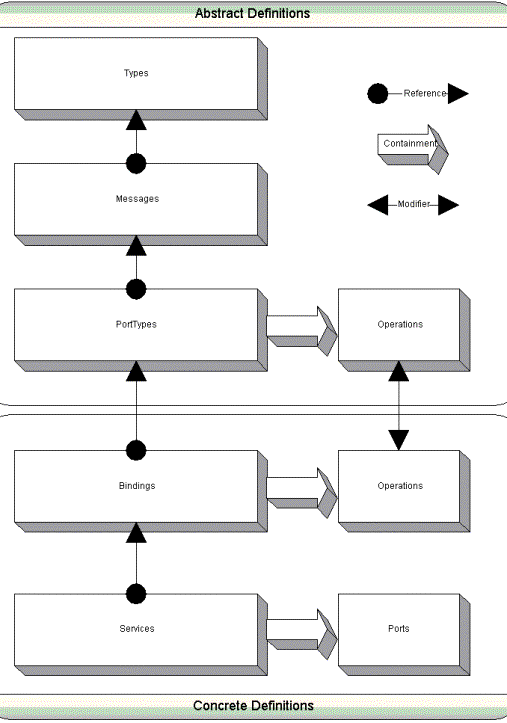WSDL 规则解释
本文共 5220 字,大约阅读时间需要 17 分钟。
WSDL文档可以分为两部分。 顶部分由抽象定义组成,而底部分则由具体描述组成。抽象部分以独立于平台和语言的方式定义SOAP消息,它们并不包含任何随机器或语言而变的元素。这就定义了一系列服务,截然不同的网站都可以实现。随网站而异的东西如序列化便归入底部分,因为它包含具体的定义。 l 抽象定义 Types 独立与机器和语言的类型定义  首先看看一段简单的JAVA代码,我们用它作为WSDL的服务实现代码:
首先看看一段简单的JAVA代码,我们用它作为WSDL的服务实现代码: 
 public class Test
public class Test  {
{ 
 public String echo(String u)
public String echo(String u)  {
{  return "Hello " + u;
return "Hello " + u;  }
}  }
}  看看它导出的文件:
看看它导出的文件:  //第一行申明该文档是XML。尽管这并不是必需的,但它有助于XML解析器决定是否解析WSDL文件或只是报错。第二行是WSDL文档的根元素:<definitions>。一些属性附属于根元素,就像<schema>子元素对于<types>元素。 <? xml version="1.0" encoding="UTF-8" ?>
//第一行申明该文档是XML。尽管这并不是必需的,但它有助于XML解析器决定是否解析WSDL文件或只是报错。第二行是WSDL文档的根元素:<definitions>。一些属性附属于根元素,就像<schema>子元素对于<types>元素。 <? xml version="1.0" encoding="UTF-8" ?>  - < wsdl:definitions targetNamespace ="http://localhost/axis/Test2.jws" xmlns:wsdl ="http://schemas.xmlsoap.org/wsdl/" xmlns:xsd ="http://www.w3.org/2001/XMLSchema" xmlns:soapenc ="http://schemas.xmlsoap.org/soap/encoding/" xmlns:wsdlsoap ="http://schemas.xmlsoap.org/wsdl/soap/" xmlns:apachesoap ="http://xml.apache.org/xml-soap" xmlns:intf ="http://localhost/axis/Test2.jws" xmlns:impl ="http://localhost/axis/Test2.jws" >
- < wsdl:definitions targetNamespace ="http://localhost/axis/Test2.jws" xmlns:wsdl ="http://schemas.xmlsoap.org/wsdl/" xmlns:xsd ="http://www.w3.org/2001/XMLSchema" xmlns:soapenc ="http://schemas.xmlsoap.org/soap/encoding/" xmlns:wsdlsoap ="http://schemas.xmlsoap.org/wsdl/soap/" xmlns:apachesoap ="http://xml.apache.org/xml-soap" xmlns:intf ="http://localhost/axis/Test2.jws" xmlns:impl ="http://localhost/axis/Test2.jws" >  - <!--
- <!--  WSDL created by Apache Axis version: 1.4
WSDL created by Apache Axis version: 1.4 Built on Apr 22, 2006 (06:55:48 PDT)
Built on Apr 22, 2006 (06:55:48 PDT)
 -->
-->  - < wsdl:message name ="echoResponse" > //返回的消息
- < wsdl:message name ="echoResponse" > //返回的消息  < wsdl:part name ="echoReturn" type ="xsd:string" />
< wsdl:part name ="echoReturn" type ="xsd:string" />  </ wsdl:message >
</ wsdl:message >  - < wsdl:message name ="echoRequest" > //请求的消息
- < wsdl:message name ="echoRequest" > //请求的消息  < wsdl:part name ="u" type ="xsd:string" />
< wsdl:part name ="u" type ="xsd:string" />  </ wsdl:message > <definitions> 元素包含一个或多个
</ wsdl:message > <definitions> 元素包含一个或多个  - < wsdl:portType name ="Test2" > //一个portType可以看成一个类
- < wsdl:portType name ="Test2" > //一个portType可以看成一个类  - < wsdl:operation name ="echo" parameterOrder ="u" > //一个operation就是一个方法
- < wsdl:operation name ="echo" parameterOrder ="u" > //一个operation就是一个方法  < wsdl:input name ="echoRequest" message ="impl:echoRequest" /> //输入消息
< wsdl:input name ="echoRequest" message ="impl:echoRequest" /> //输入消息  < wsdl:output name ="echoResponse" message ="impl:echoResponse" /> //返回消息
< wsdl:output name ="echoResponse" message ="impl:echoResponse" /> //返回消息  </ wsdl:operation >
</ wsdl:operation >  </ wsdl:portTyp> 消息传递和传输: 我以一种抽象方式定义了操作和消息,而不考虑实现的细节。实际上,WSDL 的任务是定义或描述 Web 服务,然后提供一个对外部框架的引用来定义 WSDL 用户将如何实现这些服务。可以将这个框架当作 WSDL 抽象定义和它们的实现之间的“ 绑定(
</ wsdl:portTyp> 消息传递和传输: 我以一种抽象方式定义了操作和消息,而不考虑实现的细节。实际上,WSDL 的任务是定义或描述 Web 服务,然后提供一个对外部框架的引用来定义 WSDL 用户将如何实现这些服务。可以将这个框架当作 WSDL 抽象定义和它们的实现之间的“ 绑定(
Messages
包括函数参数(输入与输出分开)或文档描述PortTypes
引用消息部分中消息定义来描述函数签名(操作名、输入参数、输出参数)2 具体定义
Bindings PortTypes部分的每一操作在此绑定实现Services
确定每一绑定的端口地址 下面的图中,箭头连接符代表文档不同栏之间的关系。点和箭头代表了引用或使用关系。双箭头代表"修改"关系。3-D的箭头代表了包含关系。这样,各Messages栏使用Types栏的定义,PortTypes栏使用Messages栏的定义;Bindings栏引用了PortTypes栏,Services栏引用Bindings栏,PortTypes和Bindings栏包含了operation元素,而Services栏包含了port元素。PortTypes栏里的operation元素由Bindings栏里的operation元素进一步修改或描述。 首先看看一段简单的JAVA代码,我们用它作为WSDL的服务实现代码:
首先看看一段简单的JAVA代码,我们用它作为WSDL的服务实现代码: 
 public class Test
public class Test  {
{ 
 public String echo(String u)
public String echo(String u)  {
{  return "Hello " + u;
return "Hello " + u;  }
}  }
} 
 //第一行申明该文档是XML。尽管这并不是必需的,但它有助于XML解析器决定是否解析WSDL文件或只是报错。第二行是WSDL文档的根元素:<definitions>。一些属性附属于根元素,就像<schema>子元素对于<types>元素。 <? xml version="1.0" encoding="UTF-8" ?>
//第一行申明该文档是XML。尽管这并不是必需的,但它有助于XML解析器决定是否解析WSDL文件或只是报错。第二行是WSDL文档的根元素:<definitions>。一些属性附属于根元素,就像<schema>子元素对于<types>元素。 <? xml version="1.0" encoding="UTF-8" ?>  - < wsdl:definitions targetNamespace ="http://localhost/axis/Test2.jws" xmlns:wsdl ="http://schemas.xmlsoap.org/wsdl/" xmlns:xsd ="http://www.w3.org/2001/XMLSchema" xmlns:soapenc ="http://schemas.xmlsoap.org/soap/encoding/" xmlns:wsdlsoap ="http://schemas.xmlsoap.org/wsdl/soap/" xmlns:apachesoap ="http://xml.apache.org/xml-soap" xmlns:intf ="http://localhost/axis/Test2.jws" xmlns:impl ="http://localhost/axis/Test2.jws" >
- < wsdl:definitions targetNamespace ="http://localhost/axis/Test2.jws" xmlns:wsdl ="http://schemas.xmlsoap.org/wsdl/" xmlns:xsd ="http://www.w3.org/2001/XMLSchema" xmlns:soapenc ="http://schemas.xmlsoap.org/soap/encoding/" xmlns:wsdlsoap ="http://schemas.xmlsoap.org/wsdl/soap/" xmlns:apachesoap ="http://xml.apache.org/xml-soap" xmlns:intf ="http://localhost/axis/Test2.jws" xmlns:impl ="http://localhost/axis/Test2.jws" >  - <!--
- <!--  WSDL created by Apache Axis version: 1.4
WSDL created by Apache Axis version: 1.4 Built on Apr 22, 2006 (06:55:48 PDT)
Built on Apr 22, 2006 (06:55:48 PDT)
 -->
--> 定义好操作(或方法)以后,现在需要指定将向它们发送和从它们返回的参数。在 WSDL 术语中,所有参数称为“消息”。认为您是在递送消息而结果得到返回的消息是有用的。方法调用是这样一种操作:它准备返回“消息”来响应进入的消息。
<message>元素包含了Messages栏。如果我们把操作看作函数,<message>元素定义了那个函数的参数。<message>元素中的每个<part>子元素都和某个参数相符。输入参数在<message>元素中定义,与输出参数相隔离--输出参数有自己的<message>元素。兼作输入、输出的参数在输入输出的<message>元素中有它们相应的<part>元素。输出<message>元素以"Response"结尾,就像以前所用的"fooResponse"。每个<part>元素都有名字和类型属性,就像函数的参数有参数名和参数类型。 - < wsdl:message name ="echoResponse" > //返回的消息
- < wsdl:message name ="echoResponse" > //返回的消息  < wsdl:part name ="echoReturn" type ="xsd:string" />
< wsdl:part name ="echoReturn" type ="xsd:string" />  </ wsdl:message >
</ wsdl:message >  - < wsdl:message name ="echoRequest" > //请求的消息
- < wsdl:message name ="echoRequest" > //请求的消息  < wsdl:part name ="u" type ="xsd:string" />
< wsdl:part name ="u" type ="xsd:string" />  </ wsdl:message > <definitions> 元素包含一个或多个
</ wsdl:message > <definitions> 元素包含一个或多个 <portType> 元素,实际上,每个元素都是您希望表示的一系列 operation 。或者,您也可以将单个 portType 元素看作是将各种方法组成类的一个逻辑分组。例如,如果您的供应链管理解决方案需要在客户和供应商之间进行交互,您最可能做的是分别定义与他们交互的功能性;也就是说,您将为用户和供应商各定义一个 portType。应该将每个 portType 称为 服务,因此整个 WSDL 文件将成为一个服务集合。  - < wsdl:portType name ="Test2" > //一个portType可以看成一个类
- < wsdl:portType name ="Test2" > //一个portType可以看成一个类  - < wsdl:operation name ="echo" parameterOrder ="u" > //一个operation就是一个方法
- < wsdl:operation name ="echo" parameterOrder ="u" > //一个operation就是一个方法  < wsdl:input name ="echoRequest" message ="impl:echoRequest" /> //输入消息
< wsdl:input name ="echoRequest" message ="impl:echoRequest" /> //输入消息  < wsdl:output name ="echoResponse" message ="impl:echoResponse" /> //返回消息
< wsdl:output name ="echoResponse" message ="impl:echoResponse" /> //返回消息  </ wsdl:operation >
</ wsdl:operation >  </ wsdl:portTyp>
</ wsdl:portTyp> binding )”。 当前,最流行的绑定( binding )技术是使用简单对象访问协议(SOAP)。WSDL 将指定能够访问 Web 服务实际实现的 SOAP 服务器,并且从那时起 SOAP 的整个任务就是将用户从 WSDL 文件带到它的实现。
WSDL 编写的第三个步骤是描述将 SOAP 与 WSDL 文件绑定到一起的过程。您将把  <wsdlsoap:binding/> 元素。该元素的用途是声明将把 SOAP 作为绑定和传输服务使用
<wsdlsoap:binding/> 元素。该元素的用途是声明将把 SOAP 作为绑定和传输服务使用  <wsdlsoap:binding style="rpc" transport="http://schemas.xmlsoap.org/soap/http" />
<wsdlsoap:binding style="rpc" transport="http://schemas.xmlsoap.org/soap/http" />  WSDL
WSDL  //下面将WSDL描述与具体实现进行绑定,这里采用SOAP方式
//下面将WSDL描述与具体实现进行绑定,这里采用SOAP方式 - <wsdl:operation name="echo">
- <wsdl:operation name="echo"> <wsdlsoap:operation soapAction="" />
<wsdlsoap:operation soapAction="" />  - <wsdl:input name="echoRequest">
- <wsdl:input name="echoRequest"> <wsdlsoap:body use="encoded" encodingStyle="http://schemas.xmlsoap.org/soap/encoding/" namespace="http://DefaultNamespace" />
<wsdlsoap:body use="encoded" encodingStyle="http://schemas.xmlsoap.org/soap/encoding/" namespace="http://DefaultNamespace" />  </wsdl:input>
</wsdl:input> - <wsdl:output name="echoResponse">
- <wsdl:output name="echoResponse"> <wsdlsoap:body use="encoded" encodingStyle="http://schemas.xmlsoap.org/soap/encoding/" namespace="http://localhost/axis/Test2.jws" />
<wsdlsoap:body use="encoded" encodingStyle="http://schemas.xmlsoap.org/soap/encoding/" namespace="http://localhost/axis/Test2.jws" />  </wsdl:output>
</wsdl:output> </wsdl:operation>
</wsdl:operation> </wsdl:binding>
</wsdl:binding> //下面将发布的服务与前面的SOAP绑定进行关联
//下面将发布的服务与前面的SOAP绑定进行关联 - <wsdl:service name="Test2Service">
- <wsdl:service name="Test2Service"> - <wsdl:port name="Test2" binding="impl:Test2SoapBinding">
- <wsdl:port name="Test2" binding="impl:Test2SoapBinding"> <wsdlsoap:address location="http://localhost/axis/Test2.jws" />
<wsdlsoap:address location="http://localhost/axis/Test2.jws" />  </wsdl:port>
</wsdl:port> </wsdl:service>
</wsdl:service>
每个namespace属性都声明了一个缩略语,用在文档中。例如"xmlns:xsd"就为 http://www.w3.org/2001/XMLSchema定义了一个缩略语(xsd)。这就允许对该namespace的引用只需简单的在名字前加上前缀就可以了,如:"xsd:int"中的"xsd"就是合法的类型名。普通范围规则可运用于缩略前缀。也就是说,前缀所定义的元素只在元素中有效。 Namespace派什么用?namespace的作用是要避免命名冲突。如果我建立一项Web Service,其中的WSDL文件包含一个名为"foo"的元素,而你想要使用我的服务与另一项服务连接作为补充,这样的话另一项服务的WSDL文件就不能包含名为"foo"的元素。两个服务器程序只有在它们在两个事例中表示完全相同的东西时,才可以取相同的名字。如果有了表示区别的namespace,我的网络服务里的"foo"就可以表示完全不同于另一个网络服务里"foo"的含义。在你的客户端里,你只要加以限制就可以引用我的"foo"。 见下例:http://www.infotects.com/fooService#foo 就是完全限制的名字,相当于"carlos:foo",如果我声明了carlos作为http://www.infotects.com/fooService的快捷方式。请注意namespace中的URL是用来确定它们的唯一性的,同时也便于定位。URL所指向的地方不必是实际存在的网络地址,也可以使用GUID来代替或补充URL。例如,GUID"335DB901-D44A-11D4-A96E-0080AD76435D"就是一个合法的namespace指派。 targetNamespace属性声明了一个namespace,元素中所有的声明的名字都列于其内。在WSDL示例中,<definitions>的targetNamespace 是。这意味着所有在WSDL文档中声明的名字都属于这个namespace。<schema>元素有自己的targetNamespace属性,其值为 ,在<schma>元素中定义的所有名字都属于这个namespace而不是main的target namespace。 <binding> 元素包括到 <definitions> 元素内。这个 binding 元素应该有 name 和 type 属性。 name 将标识这个绑定而 type 将标识您希望与这个绑定相关联的 portType(一组操作)。 < wsdl:binding name ="Test2SoapBinding" type ="impl:Test2" >  <wsdlsoap:binding/> 元素。该元素的用途是声明将把 SOAP 作为绑定和传输服务使用
<wsdlsoap:binding/> 元素。该元素的用途是声明将把 SOAP 作为绑定和传输服务使用 <wsdlsoap:binding> 元素有两个属性:style 和 transport。style 是一个可选属性,它描述该绑定内操作的性质。transport 属性指定 HTTP 作为该绑定将使用的级别较低的传输服务。SOAP 客户机将从 WSDL 文件中读取 SOAP 结构并与另一端的 SOAP 服务器协调.
 <wsdlsoap:binding style="rpc" transport="http://schemas.xmlsoap.org/soap/http" />
<wsdlsoap:binding style="rpc" transport="http://schemas.xmlsoap.org/soap/http" />  WSDL
WSDL <operation> 元素,分别表示具体的操作。每个 <operation> 元素提供各自操作的绑定细节。因此,我提供了另一个 extensibility 元素,即 <wsdlsoap:operation/> (仍然是一个空元素,与它发生的那个操作相关)。该 <soap:operation/> 元素有一个 soapAction 属性,SOAP 客户机将使用该属性创建 SOAP 请求。  //下面将WSDL描述与具体实现进行绑定,这里采用SOAP方式
//下面将WSDL描述与具体实现进行绑定,这里采用SOAP方式 - <wsdl:operation name="echo">
- <wsdl:operation name="echo"> <wsdlsoap:operation soapAction="" />
<wsdlsoap:operation soapAction="" />  - <wsdl:input name="echoRequest">
- <wsdl:input name="echoRequest"> <wsdlsoap:body use="encoded" encodingStyle="http://schemas.xmlsoap.org/soap/encoding/" namespace="http://DefaultNamespace" />
<wsdlsoap:body use="encoded" encodingStyle="http://schemas.xmlsoap.org/soap/encoding/" namespace="http://DefaultNamespace" />  </wsdl:input>
</wsdl:input> - <wsdl:output name="echoResponse">
- <wsdl:output name="echoResponse"> <wsdlsoap:body use="encoded" encodingStyle="http://schemas.xmlsoap.org/soap/encoding/" namespace="http://localhost/axis/Test2.jws" />
<wsdlsoap:body use="encoded" encodingStyle="http://schemas.xmlsoap.org/soap/encoding/" namespace="http://localhost/axis/Test2.jws" />  </wsdl:output>
</wsdl:output> </wsdl:operation>
</wsdl:operation> </wsdl:binding>
</wsdl:binding> //下面将发布的服务与前面的SOAP绑定进行关联
//下面将发布的服务与前面的SOAP绑定进行关联 - <wsdl:service name="Test2Service">
- <wsdl:service name="Test2Service"> - <wsdl:port name="Test2" binding="impl:Test2SoapBinding">
- <wsdl:port name="Test2" binding="impl:Test2SoapBinding"> <wsdlsoap:address location="http://localhost/axis/Test2.jws" />
<wsdlsoap:address location="http://localhost/axis/Test2.jws" />  </wsdl:port>
</wsdl:port> </wsdl:service>
</wsdl:service> <schema>元素的以下这行声明了默认的namespace。Schema中所有有效的名字都属于这个namespace。
转载地址:http://wwbgx.baihongyu.com/
你可能感兴趣的文章
3.使用maven创建java web项目
查看>>
笔记本搜索不到某一AP广播的SSID,信道的原因
查看>>
基于Spring MVC的异常处理及日志管理
查看>>
MediaBrowserService 音乐播放项目《IT蓝豹》
查看>>
MySQL入门12-数据类型
查看>>
Windows Azure 保留已存在的虚拟网络外网IP(云服务)
查看>>
修改字符集
查看>>
HackTheGame 攻略 - 第四关
查看>>
js删除数组元素
查看>>
带空格文件名的处理(find xargs grep ..etc)
查看>>
华为Access、Hybrid和Trunk的区别和设置
查看>>
centos使用docker下安装mysql并配置、nginx
查看>>
关于HTML5的理解
查看>>
需要学的东西
查看>>
Internet Message Access Protocol --- IMAP协议
查看>>
Linux 获取文件夹下的所有文件
查看>>
对 Sea.js 进行配置(一) seajs.config
查看>>
dom4j解析xml文件
查看>>
第六周
查看>>
斯坦福大学公开课机器学习:梯度下降运算的学习率a(gradient descent in practice 2:learning rate alpha)...
查看>>